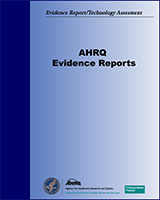NCBI Bookshelf. A service of the National Library of Medicine, National Institutes of Health.
This publication is provided for historical reference only and the information may be out of date.
Structured Abstract
Objectives:
We conducted a systematic review of published evidence on four common musculoskeletal disorders affecting workers; carpal tunnel syndrome (CTS), cubital tunnel syndrome, epicondylitis, and de Quervain's disease. This report is a “Best Evidence” synthesis in which we address the best available evidence, not the best possible evidence. We addressed 13 key questions regarding their diagnosis, treatment, and costs.
Search Strategy:
To identify information for this report, we searched 31 databases, relevant web sites, four U.S. government datasets, hand-searched the reference lists of all studies retrieved for this evidence report, searched Current Contents-Clinical Medicine weekly, and reviewed over 1,600 documents maintained in ECRI's collections.
Selection Criteria:
To be selected for evaluation, a published study had to enroll patients diagnosed with one of the four relevant disorders. All controlled trials were retrieved, regardless of year of publication or whether they were described as randomized or prospective. Other studies were evaluated only if they were published in 1980, or later, and included 10 or more patients. Only English-language articles were retrieved. After retrieval, documents were examined to ensure that they did not contain flaws (e.g. confounding, incomparable study groups) precluding interpretation of results.
Data Collection and Analysis:
Data about trial design, patient signs, symptoms, comorbidities, characteristics, and treatments, treatment outcomes and diagnostic measurements were abstracted from articles meeting inclusion criteria using electronic forms. Data were meta-analyzed when possible. Other analyses included corrections for patient attrition, statistical power analyses, multiple regression analyses, effect size computation, determinations of statistically significant differences between patient characteristics and verification of diagnostic test characteristics.
Main Results:
The literature describing these disorders is often of poor quality, with few studies addressing any given issue. The evidence currently available suggests the following tendencies:
Two diagnostic tests for CTS, distal motor latency and palmar sensory latency, appear to have high specificity and low-to-moderate sensitivity.
Patients who have undergone surgery for CTS are predominantly middle aged and female. It is not possible to determine the characteristics of those undergoing surgery for the other three conditions.
Studies comparing open and endoscopic carpal tunnel release show a small but statistically significant advantage for endoscopic release, despite a higher rate of complications and reoperation compared to open release.
CTS patients benefit, but may not recover fully or permanently after steroid injection into the carpal tunnel.
Published data do not support the use of neurolysis, ligament reconstruction, or ultrasound for most CTS patients.
Laser therapy does not appear to be an effective treatment for epicondylitis.
Patients with epicondylitis who were treated with acupuncture had better global outcomes and greater pain relief than patients given sham acupuncture.
Conclusions:
Published literature describing the diagnosis, treatment and impact of worker-related upper-extremity disorders is diffuse and generally of low quality, making it difficult to come to firm evidence-based conclusions. There are trends in available data, but it is often difficult to quantify them.
Contents
Prepared for: Agency for Healthcare Research and Quality, U.S. Department of Health and Human Services.1 Contract No. 290-97-0020. Prepared by: ECRI, Health Technology Assessment Group.
Suggested citation:
Chapell R, Turkelson CM, Coates V, et al. Diagnosis and Treatment of Worker-Related Musculoskeletal Disorders of the Upper Extremity. Evidence Report/Technology Assessment Number 62. (Prepared by ECRI, Health Technology Assessment Group under Contract No. 290-97-0020.) AHRQ Publication No. 02-E038 Rockville, MD: Agency for Healthcare Research and Quality. December 2002.
This report may be used, in whole or in part, as the basis for development of clinical practice guidelines and other quality enhancement tools, or as a basis for reimbursement and coverage policies. Endorsement by the Agency for Healthcare Research and Quality (AHRQ) or the U.S. Department of Health and Human Services (DHHS) of such derivative products may not be stated or implied.
AHRQ is the lead Federal agency charged with supporting research designed to improve the quality of health care, reduce its cost, address patient safety and medical errors, and broaden access to essential services. AHRQ sponsors and conducts research that provides evidence-based information on health care outcomes; quality; and cost, use, and access. The information helps heath care decisionmakers—patients and clinicians, health system leaders, and policymakers—make more informed decisions and improve the quality of health care services.
The authors of this report are responsible for its content. Statements in the report should not be construed as endorsement by the Agency for Healthcare Research and Quality or the U.S. Department of Health and Human Services of a particular drug, device, test, treatment, or other clinical service.
- 1
2101 East Jefferson Street, Rockville, MD 20852. www
.ahrq.gov
